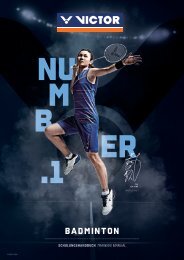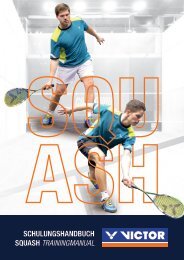Create successful ePaper yourself
Turn your PDF publications into a flip-book with our unique Google optimized e-Paper software.
Badminton racket<br />
The shape of the badminton racket is slightly<br />
smaller, lighter and thinner than a tennis racket.<br />
A racket with steel shaft weighs around 120 g,<br />
while top class rackets weighs as little as 80 g.<br />
The stiffer the frame, the more precise the game.<br />
Beginner‘s rackets are mainly strung with cheap<br />
polyester strings. Advanced players and<br />
professionals use more expensive natural gut<br />
strings or multifilament polyester strings, which<br />
allow better control and longlasting durability.<br />
Depending on the type of player, badminton<br />
rackets can be strung with a variable strength<br />
(tension between 18-26lbs). Because of the<br />
oval shape of the racket head, the vertical<br />
strings are mostly strung 1-2lbs tighter than the<br />
lateral strings.<br />
Stringing Tip: Beginner / advanced player 20-22lbs. Competition:<br />
24lbs+. The higher the stringing tension the more technique is needed.<br />
THE ATTITUDE OF PLAYERS IN THE LONG RUN HAS<br />
INFLUENCED THE DEVELOPMENT OF THE RACKETS<br />
ENORMOUSLY.<br />
BEGINNER RACKETS<br />
These rackets are inexpensive and have long<br />
lasting durability. Generally durable materials<br />
like steel and aluminium are used. These rackets<br />
have a conflict between weight/comfort<br />
and sensitivity/durability, therefore often top<br />
class strings are used to increase the playability.<br />
Generally these rackets are used in schools<br />
and leisure centres.<br />
INTERMEDIATE RACKETS<br />
With this type of rackets, an ideal combination<br />
of power and control is important. Rackets<br />
with a flexible shaft and a warp resistant head<br />
offer the optimal compromise between acceleration<br />
and precision. To increase this effect<br />
even more you should choose a racket with a<br />
high frame profile. High quality materials like<br />
graphite and titanium allow a light frame weight<br />
and good handling. Allround players choose a<br />
racket with a balanced distribution which means<br />
it is neither head nor grip heavy. These<br />
rackets are favoured in schools, leisure centres<br />
and some clubs.<br />
COMPETITIVE PLAYERS /<br />
PROFESSIONALS<br />
High level players need a light racket with maximum<br />
control. Rackets with a flexible shaft<br />
increase the acceleration of the shuttle. A very<br />
stiff racket head means a high quality of precision<br />
will be generated. High class rackets like<br />
these are used by experienced players.<br />
For maximum power a racket with a flexible shaft<br />
and minimum weight is needed. This is assured<br />
using premium carbon in the shaft connected<br />
with material like titanium and Kevlar ® . Offensive<br />
players prefer head-heavy rackets for additional<br />
acceleration, while defensive players prefer<br />
grip-heavy rackets.<br />
These types of rackets are regularly constructed<br />
in “one-piece“ or “real one piece“ structures.<br />
Premium materials such as carbon fibres,<br />
i.e. ceramic, boron or Kevlar ® , are often added<br />
to the base material graphite to optimise the<br />
playability of the racket. The proportion of this<br />
admixture is about 5% to 10%. This type of racket<br />
is used by club and tournament standard players.<br />
klassische Kopfform<br />
classical head shape<br />
Stahl steel günstig, sehr haltbar cheap, longlasting<br />
Stahl/Alu<br />
Carbon/Alu<br />
Graphite<br />
günstiger, haltbarer als Carbon<br />
cheap, longer durability<br />
leichter als Stahl, gute Haltbarkeit<br />
lighter than steel, good durability<br />
sehr leicht, sehr flexibel<br />
very light, very flexible<br />
schwer, kaum Flexibilität heavy, minimum flexibility<br />
schwerer, weniger Flexibilität als Carbon<br />
heavier than carbon, little flexibility<br />
teurer als Stahl/ Alu, kaum Flexibilität<br />
more expensive, less flexible than carbon<br />
teuerste Variante, nicht so haltbar<br />
more expensive, less durability<br />
isometrische Kopfform<br />
isometric head shape<br />
11
















